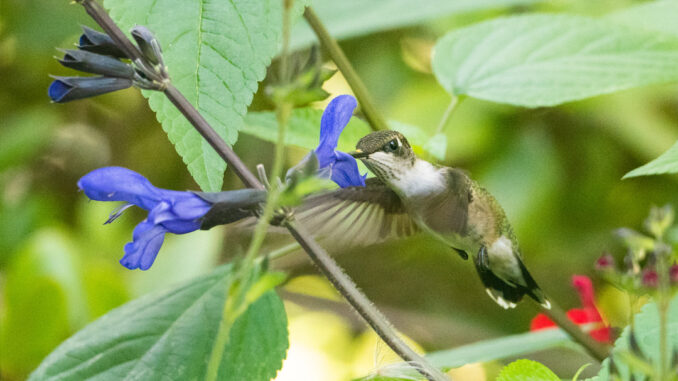
Once again at home, summer is a familiar setting of colourful blooms, soft breezes and yourself in a lounge chair. But what’s that in the air? Could it be a perfume so intoxicating that it draws you deeper into the green? Filling containers with perfumed plants is one way to experience summer in a completely ‘scentsational’ way.
Beyond petals
Flowering summer annuals provide a backbone of vibrant colour in summer containers but, for a fuller sensual experience, consider flowering plants with the bonus of fragrant foliage. Adding containers of these tropical ornamentals will greatly enhance a scented garden experience.
Lavender is a good choice for containers close to a seating arrangement, where the slightest brush of a hand releases the classic fragrance into the air. Lavender has been commercially grown for more than 100 years and, in that time, many hybrids have been developed. Among them is ‘Twickel Purple’ (Lavendula angustifolia ‘Twickel Purple’), developed at Twickel Castle in Holland before 1922. This hybrid lavender is noticeably larger than any others in the category. With grey-green leaves and dense purple flowers on spikes appearing in fan-like clusters, ‘Twickel Purple’ would be an asset all summer. The strongly upright lines of lavender branches could be enhanced with a few clumps of lobelia to cascade over the edges.
Feverfew is a hardy perennial plant that has been familiar in cottage gardens for centuries. Its soft and lacy foliage is deeply honey-scented and a pleasure to touch, sending sweet perfume into the air. Charming white daisy flowers with yellow centres appear generously in early to mid-summer. In addition to the standard plant (18 to 24 inches) with classic single flowers, there are some feverfew hybrids available. Golden feverfew ‘Aureum’ is a dwarf (12 to 14 inches) clump-forming plant with chartreuse foliage turning to green in summer and covered with white single daisies. ‘White Pompom’ has double flowers. ‘Tetra White’ is another double flower with fluffy white snowball-like blooms. Plants are available at garden centres and may sometimes be found in the herb section. They’re also easy to grow from seed.
Hummingbird sage ‘Black and Blue’ (Salvia guaranitica ‘Black and Blue’) is a frost tender tropical plant that grows quickly in a large container. Its long stems carry fruit-scented slightly fuzzy leaves and attractive funnel-shaped blue-and-black flowers. It is constantly in flower through summer months and has great appeal to hummingbirds. If you’ve never had a chance to see these amazing hummers up close, this will be your best opportunity. Once they discover the plant, you can expect frequent visits throughout the day.
Tropical-scented plants are available from garden centres and through online mail order purchase. These scented plants will perform well in patio containers, with half a day or more of sun. Use a purchased soilless planting mix and water three or more times a week, as needed. Commercial liquid fertilizer provided every two to three weeks will keep plants growing and blooming for as long as possible.
If you’re planting into traditional clay pots, be aware that this is a porous material and will transpire water through the sides of the pots. Terra cotta pots tend to dry out soil quickly and may require more frequent watering. This is easily avoided by lining the pots with thin plastic sheets (such as grocery carriers or dry-cleaning bags), being sure to cut a large hole in the bottom allowing water to drain. Settle the plastic film into the pots and press it along the pot walls, then cut a large hole in the bottom. Fill with soilless potting mix and set your plants into the pot, gently firming them into position. Trim excess protruding plastic at half an inch above soil level. Provide water and fertilizer, and enjoy the sweet scents all summer.
Some petunias make good scents
Sometimes the sweetest flower scents are found in unexpected blossoms. Petunias might not be first on the list when considering scented flowers; at best, many petunias have only a slight musky scent that wouldn’t be considered true flower fragrance. But some deeply perfumed petunias have been unexpectedly popping up in greenhouses and, be assured, your nose is not fooling you.
Decades of petunia hybridizing has resulted in plants with a wide colour spectrum and diverse features – vivid bicolours, double-frilled petals, spreading ground covers, cascading waves for containers and neat mounds for edging. But no mention of scented petunias, especially those with enough perfume to be described as intoxicating. Yet sniffing your way down the greenhouse petunia aisle, you may find a petunia selection puffing out enough deep vanilla scent to cause swooning. What is this about?
Early in the previous century, native white Petunia axillaris was selected from Argentinian highlands plants and bred with another native specie, violet P. integrifolia. Both species produce substantial amounts of volatile benzenoid chemicals that synthesize perfume in petals. Scent is a primary function of reproduction in flowers and P. axillaris uses its deep vanilla perfume to attract night-flying hawk moths; while P. integrifolia uses scent to attract pollinator bees in sunlight.
Twenty-first century petunias are developed for their colour and form choices, with little focus on petal scent. But genes from those original Argentinian species are still floating around in modern petunias and causing some delicious perfumes to unexpectedly cast a cloud of vanilla through your patio and garden spaces. Any scented flower has its lowest scent potential in bright midday sun. But in cool morning hours and from late afternoon into darkness, petunias are sending their scent messages out to potential pollinators – and that could include you!
When cruising garden centre aisles in cool mornings, it’s worthwhile taking a deep sniff of any petunias with dark purple, pale purple with dark veining, mauve, bicolours with white, and pure white flowers. These are the most likely to still retain errant perfume genes and you can look for them as box plants. Named varieties known to be scented are ‘Scentsation’, ‘Daddy Blue’, ‘Blue Storm’, ‘Madness Plum Crazy’ and ‘Prism Sunshine’. These are also available as seed and are easy to start indoors in late winter. Almost every form of petunia is adaptable to container planting, requiring a sunny location and consistent watering. Fertilize every two weeks for a full summer of beautiful flowers and, hopefully, dizzying scents.


